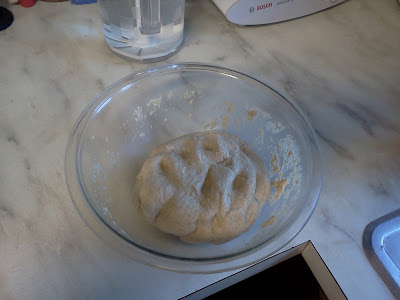Have you ever heard of kombucha?
Kombucha is a fermented drink made using tea and sugar and a starter, called a scoby. Scoby stands for "symbiotic culture of bacteria and yeasts."
Here is a little blurb about kombucha that I found at seedsofhealth website.
A couple of months ago, my mother in law gave me a kombucha scoby. I made it once, it didn't ferment quite like it was supposed to-- when properly fermented, it gets slightly effervescent-- and I just kept putting off brewing tea to make it. Now that Thanksgiving and Christmas have passed, and I am trying all kinds of new things in the kitchen (and also on my sewing machine!), I made time to brew some more tea to make some more kombucha. (You would think, as I drink tea multiple times throughout the day, that I would not have to 'make time' for this. And really, I didn't. I was just telling myself I would have to make all this time for it and thus putting it off and putting it off... ANYway...)
Making kombucha at home could not be easier. Seriously. And, if you already know about this stuff and how good it is, and you already have a craving desire for it, let me save you some (a lot of) money! Get a kombucha scoby! I can share mine with you, if you want and you are in the area.
Ok, so here is how I have been making mine, which method I got from Nourishing Traditions by Sally Fallon. (Great, awesome book, with lots of information and TONS of recipes covering all types of food.) I seriously recommend this book to anyone who is serious about their health and crazy enough to think outside the conventional-food-available box. :-)
Am I rambling a lot this evening, or is it just me?
Back to the recipe...
Kombucha
One scoby
1/2 cup of kombucha from another batch
2 tea bags
1/2 cup white sugar (I use organic cane sugar)
2 quarts of water
1/2 gallon jar
boil the water. add the tea bags and the sugar. stir until sugar is dissolved. let tea brew until it has completely cooled. pour tea, scoby, and kombucha into the glass jar. cover with a cloth (and I put a rubber band around the top). leave on the counter 1 week- 3 weeks, until the kombucha is tasty and has bubbles around the edges.
 |
| My latest batch of Kombucha-- you can see the scoby floating around in there. Actually there are two 'mushrooms' that have separated... |
After a week or so on the counter, a new 'mushroom' should start forming on top of your kombucha. It IS creepy, and looks slimy, but it is good! It means your kombucha is working! Start tasting the kombucha, and when it tastes good to you (the longer you let it sit, the more vinegary the flavor will be), then it is ready to drink.
You can brew another batch right away and use the scoby over again right away or store it in the fridge, with some kombucha for awhile. Mine was in there for almost two months and it still worked when I used it this month. :-) I don't know if I will be storing mine in the fridge anymore, anyway, since the entire 2 quarts of kombucha was gone in two days at my house.
Why drink this strange weird drink? Well, for one it tastes delicious. It has a bit of bubbly-ness that is reminiscent of when I used to drink soda. Also, it is packed full of B vitamins and other things like antioxidants and even more things that I don't know about because I honestly haven't looked up ALL the health benefits. :-)
Also, it's super cute to have your almost two year old say, "More kombucha, please, Mommy." :-)





















